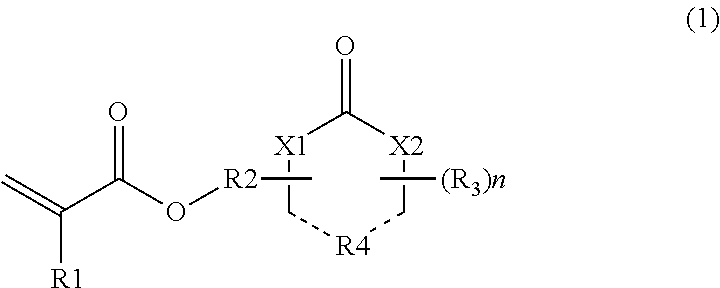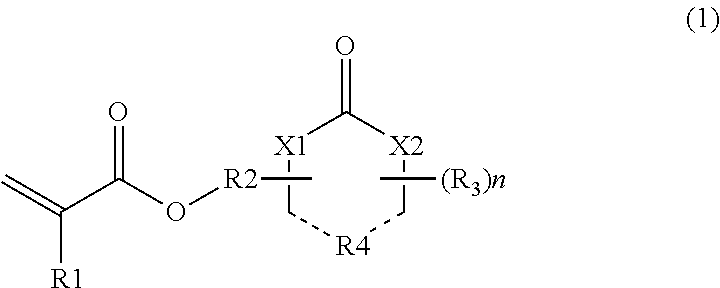Anisotropic conductive film, connection structure and method of producing the same
a technology connection structure, which is applied in the direction of film/foil adhesives without carriers, non-metal conductors, conductors, etc., can solve the problems of insufficient adhesive strength of the cure product of the thermosetting adhesive composition, and achieve the improvement of anisotropic conductive film adhesive strength, improved connection reliability, and reduced conduction resistance value
- Summary
- Abstract
- Description
- Claims
- Application Information
AI Technical Summary
Benefits of technology
Problems solved by technology
Method used
Image
Examples
reference example 1
[0048]Acrylic acid (72.1 g, 1 mole), α-hydroxy-γ-butyrolactone (112.3 g, 1.1 mole), 3 g of p-toluenesulfonic acid, and 1 L of toluene were placed in a reactor, and then heated and refluxed while removing water for 5 hours for esterification. Toluene was distilled and removed under reduced pressure, and the residue was distilled under reduced pressure. Accordingly, γ-butyrolactone-2-yl acrylate was obtained in a yield of 50%.
reference example 2
Synthesis of Cyclic Carbonate Acrylate
[0049]The same synthesis process as in Reference Example 1 was repeated, except that 4-hydroxymethyl-1,3-dioxolane-2-one was used instead of α-hydroxy-γ-butyrolactone, thereby yielding 1,3-dioxolane-2-one-4-yl methyl acrylate.
reference example 3
[0050]The same synthesis process as in Reference Example 1 was repeated, except that α-hydroxy-γ-butyrolactam was used instead of α-hydroxy-γ-butyrolactone, thereby yielding γ-butyrolactam-2-yl acrylate.
PUM
| Property | Measurement | Unit |
|---|---|---|
| size | aaaaa | aaaaa |
| size | aaaaa | aaaaa |
| thickness | aaaaa | aaaaa |
Abstract
Description
Claims
Application Information
 Login to View More
Login to View More - R&D
- Intellectual Property
- Life Sciences
- Materials
- Tech Scout
- Unparalleled Data Quality
- Higher Quality Content
- 60% Fewer Hallucinations
Browse by: Latest US Patents, China's latest patents, Technical Efficacy Thesaurus, Application Domain, Technology Topic, Popular Technical Reports.
© 2025 PatSnap. All rights reserved.Legal|Privacy policy|Modern Slavery Act Transparency Statement|Sitemap|About US| Contact US: help@patsnap.com



